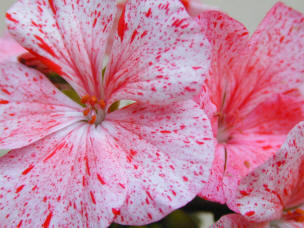Pulmonaria – Lungwort - Low Growing Perennial
We talk here of Pulmonaria the garden perennials, rather than the Lungwort of herbal remedies. The ‘Lungwort’ common name for the attractive Pulmonaria group of garden plants is a good example of why the proper botanical names should be used by gardeners.
‘Lungwort’ is a name attributed to several other plants in herbal uses and medicine – one of which is to all intents and purposes, a moss type plant! (A good reason alone, why great care should be taken in obtaining herbal remedies.)
Pulmonarias are a little-used herbaceous or sometimes evergreen perennial plants which are grown for a combination of attractively marked foliage and dainty trumpet funnel flowers which range in colours from white to red, but with blue as the predominant colour mix. The blue Pulmonarias can range from the lightest powder blue through to the darkest cobalt blue.
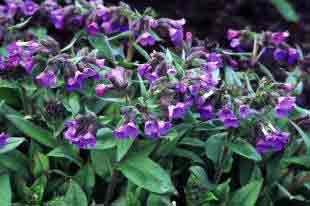 Pulmonarias flower very early in the spring – or late winter - one of
the first to do so out of the perennial group of plants. Flowering so
early, is probably one of the reasons why is has not received the
acclaim or usage that it is entitled to! (It is normally finished
flowering by the time the garden centre ‘shelf’ sales have started in
late spring) Take in the images on this page and you can see their
usefulness at a normally inhospitable time for gardening – unless you
are keen.
Pulmonarias flower very early in the spring – or late winter - one of
the first to do so out of the perennial group of plants. Flowering so
early, is probably one of the reasons why is has not received the
acclaim or usage that it is entitled to! (It is normally finished
flowering by the time the garden centre ‘shelf’ sales have started in
late spring) Take in the images on this page and you can see their
usefulness at a normally inhospitable time for gardening – unless you
are keen.
As if the flowers were not enough, there is also a wide range of foliage types and markings. They form a good dense clump of leaves at the base, with the flower stems also having a few leaves on the flower stems, which are smaller than the basal foliage.
Image of Pulmonaria angustifolia Azurea.
Leaf colours vary, from a dark but attractive hairy green, through various silver mottling or splashes on the foliage. On some varieties, the silver makings take up more leaf surface than the green.
Where and How to Grow Pulmonaria?
The short answer to that question is ‘Anywhere you have space!’ That is how accommodating they are. Pulmonarias are seemingly happy in damp or dry areas, full sun to woodland shade, alkaline or acid soil.
Most Pulmonarias grow to no more than 30cm high, but sometimes with flower stems slightly higher than that. Some are happy at a height of 15cm with flowers hugging the foliage clump.
Pulmonarias are superb ground cover plants in woodland, border or open garden situations.
When grown in full sun the foliage of the more marked types can get a little sun scorch, leaving unattractive brown markings on the foliage. An ideal situation is under the canopy of a deciduous shrub, or in a perennial border where they will be happy to flower when most perennials are still wrapped up in their winter dormancy. The emerging foliage of the perennials can then give little shelter from the sun if planted in the right situation.
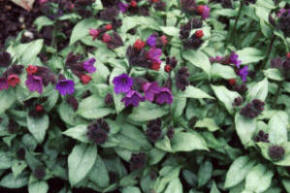
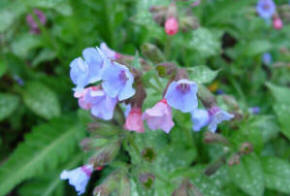
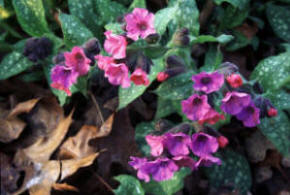
Left: Pulmonaria saccharata Argentea Group |
Centre Pulmonaria Self sown seedling | Right: Pulmonaria saccharata
type.
Many of the Pulmonarias are well suited to a permanent patio pot or other container, where the early flowers are then followed by the spear-shaped end-pointed attractively marked leaves. The foliage will persist until winter, and even though the dull winter months with the evergreen types.
Problems Growing Pulmonarias
As with most garden plants, slugs and snails are partial to the young foliage, which of course also acts as a hiding place for them during the winter!
The biggest bugbear is the fact that they can suffer from powdery mildew on the foliage in hot dry conditions. This is rarely anything other than annoying visually, and seems not to affect the plants long term. A preventative spray of fungicide in early summer normally works.
Propagation of Pulmonarias
There are several options for growing more Pulmonarias. Seed sown as soon as ripe in early summer is an easy way. So easy in fact that the plants themselves will be happy to do this for you, for they seed themselves freely. Seedlings do not normally come true to colour, and you should be prepared for seed saved froma white flowered hybrid, to present you with offspring bearing blue and pink flowers, and a variation in foliage.
Cuttings and Divisions are the only way to ensure true offspring. Divisions are easy – right after flowering. Cuttings are by way of root cuttings taken in mid winter. These will develop new buds which then go on to birth as young plants which will grow well and flower the following winter.
Best Selling Gardening Products
Popular Gardening Sections
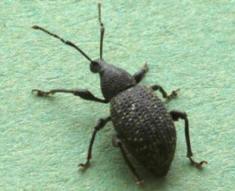
Problems
Identify Weeds in The Garden - How to deal with weeds. Diseases and Pest which harm your garden and plants, learn how to prevent, deter and erradicate your garden problems.
Garden Problems
Pruning
Pruning Guide. Shrubs flower better with correct pruning. Many illustrations and examples of what to do - and when. Includes evergreens, roses, flowering shrubs, spring flowering shrubs and pruning for stem effect. This is our most viewed and comprehensive section,
Pruning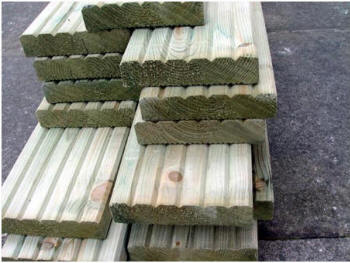
Gardening Businesses
Gardening Businesses listed in the UK counties and USA states. County and State Listings of businesses involved in Garden supplies and services. If you wish to be added to the Directory, please send us your information. Having problems, use the search box
Businesses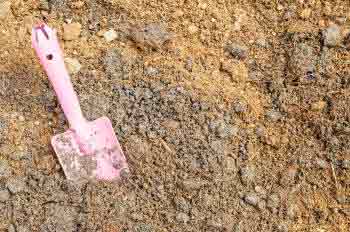
Gardening
In this section you will learn about Gardening Basics, Containers, Landscaping, Propagation and Soil.
Gardening
Gardening Gifts
Gardening Gifts and Reviews, Read Before you Buy
- Gardening Gifts Ideas
- Gifts For Her
- Gifts For Men
- Power Tool Gifts
- Cheap Gifts
- Personalised Gifts
- Wildlife Gifts
- Family Gifts


